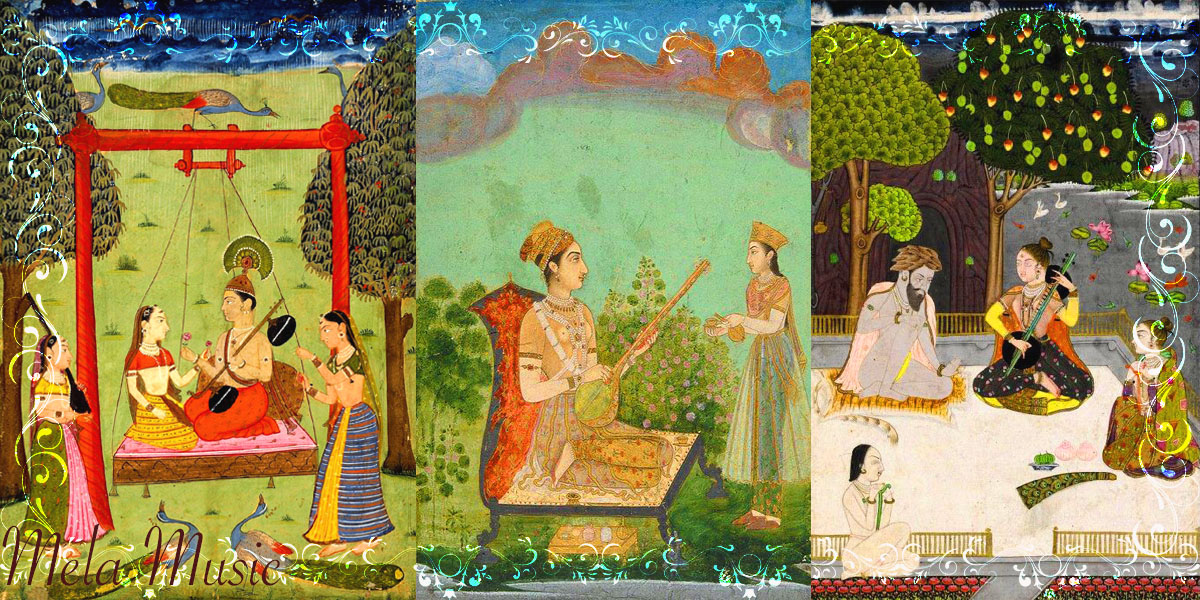
Khayal, the most popular form of classical singing in present-day Hindustani music, possesses immense potential and versatility in expressing various musical elements. Khayals are usually composed in more serious, established ragas. It incorporates a wide range of techniques such as aalap, vistar, badhat, bol-bant, laya-bol, bol-taan, sargam, gamak, taan, khatka, murki, phanda, and tihai.
The contemporary khayal has evolved from the broader framework of dhrupad, incorporating its grandeur, and draws influences from the qawwali tradition, which accounts for the faster improvisations in laya and complex sargam techniques. A khayal bandish usually is comprised two sections: asthayee and antara, sometimes with a second antara. The vistar (elaboration) is explored in the asthayee section, while the antara takes over when the melodic progression crosses the middle notes of the octave, revealing the upper SA for the first time. The composition then returns to the asthayee. As the vistar progresses, the tempo may remain the same or increase, accompanied by faster movements. New compositions are introduced with heightened laya (tempo) and often in different talas. The performance is adorned with flurries of alamkaras (ornamentations) that require creative imagination and rigorous practice. Various types of taans, including aakar taans, bol taans and chhut taans, merukhand/meerkhand, and vakra styles, along with sargams and pukars, embellish the rendition.
The Gwalior gharana is considered the oldest lineage of khayal. Its origins can be traced back to Nathan Pirbaksh and the two sons of Bade Mohammed Khan: Haddu and Hassu Khan, as well as Nathu Khan. However, the concept of khayal compositions by Amir Khusrau differed significantly. His compositions were unrelated to the musical aspect of khayal and focused more on the figurative language of poetry. According to Khusrau, khayal allowed the imagination to freely explore the objects and phenomena of the universe, thus creating a vivid mental imagery.
The music of khayal emerged as a byproduct of qawwali. Amir Khusrau’s students and followers transformed the Hindi and Persian qawwalis they learned from him into khayals within the classical music framework. The khayal compositions by Khusrau primarily emphasized tempo and gained popularity among kathak dancers, courtesans, and ordinary listeners.
Over centuries, khayal underwent changes in its musical content, structure, dimensions, and purpose. It became part of the art music genre and is now considered a form of shastriya sangeet (classical music) , incorporating various ragas. The credit for this transformation is often attributed to Niyamat Khan, also known as Shah Sadarang, a renowned khayal composer, been player, and court musician during the reign of Mughal King Muhammad Shah Rangile (1719 – 1748).
Before Sadarang, prominent personalities such as Baj Bahadur, the ruler of Malwa, and Sultan Hussain Shah Sharqee, the ruler of Jaunpur, contributed to enriching the khayal tradition. The term “khayal” originally stood for imagination and meditation, and it wasn’t associated with any specific singing style as it is today. Sultan Hussain Shah Sharqee sought to elevate khayal to an equal status with raga-based music, introducing the “Kalawanti Khayal” around 1452.
The present-day rendition of khayal consists of two distinct segments. The first segment is known as the Bada (large) Khayal, which commences with the asthayee (initial section) and antara (subsequent section) in a slow tempo, often set to rhythmic cycles such as jhumra, ektal, tilwada, or teental. In this phase, the performer introduces vistar (elaboration) and improvises, delving into the intricacies of the raga and tala, culminating each movement at the ‘sam’ (first beat of the cycle).
Following the Bada Khayal, the second segment called the Chhota (smaller and speedier) Khayal ensues. It begins at a medium-fast tempo and gradually builds up to a frenzied climax. During this phase, the artist employs various types of taan improvisations, showcasing the virtuosity of their vocal or instrumental skills. The performance may also feature occasional pukar (vocal exclamation) for dramatic effect. The Chhota Khayal is typically sung in rhythmic cycles such as drut teental, medium-fast (madhyalaya) jhaptal, or drut ektal. As the performance nears its conclusion, it is often adorned with rhythmic volleys or tihais (repetitions of a musical phrase in a cyclic manner). Throughout the entire performance, the khayal is accompanied by the tabla, a versatile percussion instrument that provides rhythmic support and embellishments.
This two-part structure of khayal allows for a gradual progression from the meditative and introspective exploration of the raga in the Bada Khayal to the energetic and exhilarating improvisations in the Chhota Khayal. It offers a dynamic and captivating musical experience for both the performers and the audience, showcasing the artist’s command over melody, rhythm, and expressive nuances within the framework of a raga. The accompanying tabla player complements and interacts with the khayal performer, enhancing the overall texture and rhythmic intricacy of the performance.
Content Provided By: Sangeetpedia
